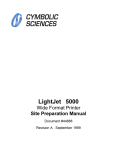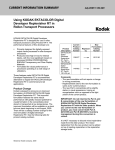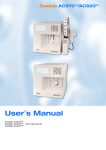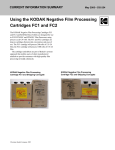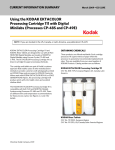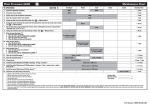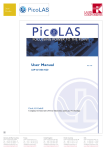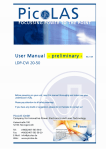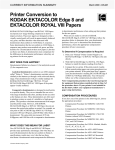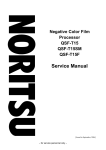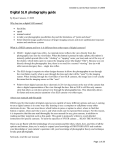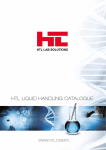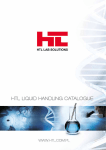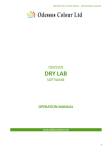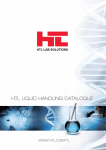Download Using KODAK EKTACOLOR PRIME LORR Chemicals and
Transcript
CURRENT INFORMATION SUMMARY May 2004 • CIS-220 Using KODAK EKTACOLOR PRIME LORR Chemicals and New KODAK EKTACOLOR PRIME SP Bleach-Fix Replenisher LORR Kodak has recently introduced a new bleach-fix replenisher to join the family of KODAK EKTACOLOR PRIME LORR Chemicals for color paper processing in minilabs. KODAK EKTACOLOR PRIME SP Bleach-Fix Replenisher LORR joins the developer as a single-part product with convenient mixing. There is also a new KODAK EKTACOLOR PRIME SP Bleach-Fix Starter that is used with EKTACOLOR PRIME SP Bleach-Fix Replenisher LORR to make fresh working tank solutions. Conversion to the new product will begin in May 2004 on a stock-turnover basis. Check with your country contacts for availability. CHOOSING THE RIGHT CHEMICALS FOR YOUR MINILAB PRIME LORR Chemicals are designed for minilabs with the time and temperature specifications in the following table. See KODAK Publication Z-130, Section 3, Process RA-4: Using KODAK EKTACOLOR Chemicals in Minilabs for more details. Solution/ Step Time sec Temperature °C (°F) PRIME LORR Starting-Point Replenishment Rate mL/m2 Note: If your minilab is operating in Europe, the Middle East, or Africa, the alternate publication, CIS-220E, specifically describes the products available in those regions. Developer 45 37.8 ± 0.3 (100.0 ± 0.5) 80 Bleach-Fix 45 30 to 36 (86 to 97) 55 The new product line consists of: Stabilizer 90 3 to 37 (86 to 99) • KODAK EKTACOLOR PRIME SP Developer Replenisher LORR KODAK EKTACOLOR PRIME SP Bleach-Fix Replenisher LORR KODAK EKTACOLOR PRIME Stabilizer and Replenisher LORR • • The replenishment rates are starting point recommendations for KODAK EKTACOLOR EDGE and ROYAL Papers. If you are processing KODAK PROFESSIONAL SUPRA ENDURA Paper, you may need to increase the developer replenishment rate up to 10 percent to maintain process control aims. The table below can help you determine the right choice for your operation. It shows which developer to choose based on the developer-tank volume and the number of 10.2 x 15.2 cm (4 x 6-inch) prints typically processed in a day. After choosing the developer, select the bleach-fix and stabilizer recommended for use with that developer. During periods of low utilization, you may need to increase the replenishment rate by 10 to 15 percent. These chemicals feature reduced replenishment rates that minimize process effluent and packaging waste. The lower rates also mean less frequent chemical mixing in busy minilab environments. KODAK EKTACOLOR PRIME LORR Chemicals are intended for customers who have an average- to high-volume operation and can benefit most from these features. Recently, KODAK EKTACOLOR PRIME SP Developer Replenisher LORR has been improved to have a more preferred lemon scent. tank volume litres 125 5 10 15 20 25 30 40 50 250 375 Prints per day 500 750 1000 1250 Note: If your lab prints 8.9 x 12.7 cm (3.5 x 5-inch) prints, 1875 * * * * * * * EKTACOLOR PRIME SP Developer Replenisher LORR EKTACOLOR RA Developer Replenisher RT * Periods of low utilisation may require a slight increase in replenishment rate ©Eastman Kodak Company, 2004 4-Tanks 195 3-Tanks 390 2500 multiply the number of prints you make each day by 0.73 to find the equivalent number of 10.2 x 15.2 cm (4 x 6-inch) prints. Use that number to select your developer. If you have identified EKTACOLOR PRIME SP Developer Replenisher LORR (for average- to highproduction volume), use these chemicals: • • • KODAK EKTACOLOR PRIME SP Developer Replenisher LORR KODAK EKTACOLOR PRIME Bleach-Fix Replenisher LORR or KODAK EKTACOLOR PRIME SP Bleach-Fix Replenisher LORR KODAK EKTACOLOR PRIME Stabilizer and Replenisher LORR If you have identified EKTACOLOR RA Developer Replenisher RT (for low-production volume), use the following chemicals: • • • KODAK EKTACOLOR Developer Replenisher RT KODAK EKTACOLOR RA Bleach-Fix and Replenisher KODAK EKTACOLOR PRIME Stabilizer and Replenisher LORR* *Note: Use the stabilizer at a replenishment rate of 248 mL/m2 (4 tanks) or 495 mL/m2 (3 tanks). ORDERING EKTACOLOR PRIME LORR CHEMICALS EKTACOLOR PRIME LORR Chemicals are available in convenient mix sizes. The catalog numbers in the following table are for the United States, Canada, and parts of Latin America. The table shows the product details and the number of 10.2 x 15.2 cm (4 x 6-inch) prints that can be processed per case. Replacement Product KODAK EKTACOLOR PRIME SP Developer Replenisher LORR KODAK EKTACOLOR PRIME SP Bleach-Fix Replenisher LORR* KODAK EKTACOLOR PRIME Stabilizer and Replenisher LORR KODAK EKTACOLOR Developer Starter (to prepare fresh tank) KODAK EKTACOLOR PRIME SP Bleach-Fix Starter (to prepare fresh tank)* CAT No. Makes Prints 864 4809 4 x 10 L 31,700 859 4301 6 x 5L 23,780 134 7806 2 x 10 gal 60,000 127 3812 2 x 10 L 23,480 844 4754 4x5L 23,480 805 5949 10 gal 44,430 826 4442 12 x 10 L 39,730 897 5146 16 x 5 L 26,480 866 9566 12 x 12.5 gal 188,000 102 6681 One bottle will make 52.8 L total fresh tank — 834 1133 4 bottles, One bottle will make 20 L total fresh tank — *To be introduced during 2004 2 Using KODAK EKTACOLOR PRIME LORR Chemicals and New KODAK EKTACOLOR PRIME SP Bleach-Fix Replenisher LORR l CIS-220 SAFE HANDLING OF PHOTOGRAPHIC CHEMICALS CONVERTING TO EKTACOLOR PRIME SP BLEACH-FIX REPLENISHER LORR Handle all chemicals carefully. When you mix solutions, wear goggles or a face shield, a protective rubber apron, and protective gloves made with neoprene or nitrile rubber. Clean protective clothing after use to remove any chemical residue that can cause contamination. For more information about potential health hazards and safe handling of specific Kodak chemicals, see the label and the Material Safety Data Sheet (MSDS) for the chemical. Consult the MSDS for regional contact information. MSDS copies are available at the Kodak website at www.Kodak.com/go/photochemicals. If you are already converted to EKTACOLOR PRIME LORR Chemicals, the conversion is very simple. The new EKTACOLOR PRIME SP Bleach-Fix Replenisher LORR may be used immediately after you have used all of the previous product. Add on top of your existing replenisher. No additional changes are required for replenishment rate, etc. MANAGING EMPTY CONTAINERS In most regions, it should be possible to participate in a local community recycling program. Check with program authorities to determine if these bottles are eligible for local recycling. See KODAK Publication No. CIS-148, Recycling KODAK Photochemical Containers, for more information on preparing the empty bottles for recycling. CIS-148 and other publications on waste management are available on the Kodak website at www.Kodak.com/go/KES. If recycling is not an option, rinse the bottles as outlined in CIS-148, render the bottles unusable (if warranted) and then dispose of with your normal solid waste. SILVER RECOVERY Publications on silver management that include recommendations and descriptions of silver-recovery options are available in the Silver Management section of the Kodak Environmental Services Publications Center at www.Kodak.com/go/KES. CONVERTING TO EKTACOLOR PRIME LORR CHEMICALS If you have not already converted to EKTACOLOR PRIME LORR Chemicals, the conversion is simple. When you have exhausted your supply of existing EKTACOLOR PRIME Chemicals, just mix the EKTACOLOR PRIME LORR Chemicals and reduce the replenishment rates. Add the new EKTACOLOR PRIME LORR Chemicals on top of your existing working tanks. If you currently use EKTACOLOR PRIME SP Developer, no change in temperature is required. You do not need to change all three solutions at the same time. As you run out of stock of your current developer, bleach-fix, or stabilizer, just make the conversion for that chemical. Preparing Fresh Working Tank Solutions To prepare one litre of developer tank solution, use 500 mL of mixed EKTACOLOR PRIME SP Developer LORR Replenisher, 45 mL of KODAK EKTACOLOR RA Developer Starter, and 455 mL of water. If you have not converted to EKTACOLOR PRIME SP Bleach-Fix Replenisher LORR, to prepare one litre of bleach-fix tank solution, use 500 mL of mixed EKTACOLOR PRIME Bleach-Fix Replenisher LORR and 500 mL of water. No bleach-fix starter is needed with EKTACOLOR PRIME Bleach-Fix Replenisher LORR. If you have converted to EKTACOLOR PRIME SP Bleach-Fix Replenisher LORR, use 950 mL of mixed replenisher and 50 mL of KODAK EKTACOLOR PRIME SP Bleach-Fix Starter. To prepare one litre of stabilizer tank solution, use mixed EKTACOLOR PRIME Stabilizer and Replenisher LORR with no further dilution. Adjusting Replenishment Rates At the time you convert to EKTACOLOR PRIME LORR Chemicals, you will need to adjust your replenishment rates to the new settings given in the table below. If you have already converted, no changes are needed when you convert to EKTACOLOR PRIME SP Bleach-Fix Replenisher LORR. We have included replenishment-rate adjustment procedures for several popular minilab models. If your equipment is not listed, check the processor manual or contact the equipment manufacturer for their recommendations. Important: If your equipment allows you to back up printer and paper processor data on a floppy disc or memory card, make sure you update your backup software after adjusting the replenishment rates. Otherwise, any future data transfer from your backup memory will revert to the old, higher replenishment rates and cause overreplenishment. Note: The replenishment rates are starting point recommendations for KODAK EKTACOLOR EDGE and ROYAL Papers. If you are processing KODAK PROFESSIONAL SUPRA ENDURA Paper, increase the developer replenishment rate by 10 percent. Using KODAK EKTACOLOR PRIME LORR Chemicals and New KODAK EKTACOLOR PRIME SP Bleach-Fix Replenisher LORR l CIS-220 3 Replenishment Rates for EKTACOLOR PRIME LORR Chemicals Solution PRIME SP Developer LORR PRIME BleachFix LORR and PRIME SP Bleach-Fix LORR PRIME Stabilizer LORR (4 tanks) PRIME Stabilizer LORR (3 tanks) mL/m* x 127 mm mL/ft* x 127 mm mL/m 10.3 3.2 80 2 mL/ft NORITSU Minilabs (1001, 1201, 1701 Series) 2 7.5 1. 2. 3. 4. 5. 6.9 2.1 55 5 6. 7. 25 7.5 195 18 49 15 390 36 8. 9. *mL per linear metre or foot NORITSU Minilabs (2900, 3100 Series) 1. From the main menu screen select “F.” 2. Highlight “Extension.” Press <YES>. 3. Enter your password if required, then press <YES>. 4. Highlight “Process Specification” or “Processor Settings” and press < YES>. 5. Move cursor to “Basic Replenisher Amount” or “Standard Replenishment Amount Settings.” 6. Enter the correct replenishment rates for each chemical (developer, bleach-fix, stabilizer). Press < YES> to accept the replenishment rates. Exit, and then return to this screen to make sure you have entered the correct replenishment rates. 10. GRETAG Master Lab 1. 2. 3. 4. 5. 6. NORITSU Minilabs (2100, 2200, 2300, 2600, 2700 Series) 1. From the main menu screen highlight “Extension” (if you see “Extension 1” and “Extension 2,” highlight “Extension 2”). Press <YES>. 2. Enter your password if required, then press <YES>. 3. Highlight “Process Specification” and press < YES>. 4. Move cursor to “Basic Replenisher Amount.” 5. Enter the correct replenishment rates for each chemical (developer, bleach-fix, stabilizer). Press < YES> to accept the replenishment rates. Exit, and then return to this screen to make sure you have entered the correct replenishment rates. Press <Mode> key. Press <Paper> key (bottom row). Press <D-IN> key. Highlight the <NO> key until the “CD Basic Repl” screen appears. Enter the new replenishment rate by using the number keys located on the bottom row. Press < YES> key. Press <NO> and the next screen, BF Basic Repl, will appear. Enter the new bleach-fix replenishment rate. Press the < YES> key. Press the <NO> key to go to the next screen, Stb Basic Repl. Enter the new stabilizer replenishment rate. Review each screen to make sure you have entered the correct replenishment rates. 7. 8. To set the developer replenishment rate, press <SET>, enter your password, press <P-Proc>, press <REPRATE>. Enter the correct replenishment rate for the developer. For GRETAG Master Labs, this will be 80 mL/m2. Press <ENTER>. To change the bleach-fix and stabilizer replenishment rates, press the following: <MAINT>, enter your password, <P. PROC>, <LIQUID>, <CALPUMP>. Enter the bleach-fix <BLEACH> (55) and stabilizer <STAB> (390 for 3 countercurrent tanks) replenishment rates. Measure and adjust the replenishment pump outputs to complete the rate change. Place one graduated cylinder for each replenisher on the frame of the paper processor. Put the replenisher tubes for each solution in the graduated cylinder. Select <COMM>, <P.PROC>, <MANREPL>, <TEST>. Check the volume in each graduated cylinder and compare them to the numbers that appear on this screen. If the volumes that the replenisher pumps deliver are different from the amounts on the screen, adjust the replenisher pumps to obtain the correct replenishment rates. Turn the adjustment screw on each pump to adjust the output—clockwise to increase the volume delivered or counterclockwise to reduce the volume. 4 Using KODAK EKTACOLOR PRIME LORR Chemicals and New KODAK EKTACOLOR PRIME SP Bleach-Fix Replenisher LORR l CIS-220 FUJI SFA Series Questions and Answers 1. Q. I am already using EKTACOLOR PRIME LORR Chemicals. When I convert to the new EKTACOLOR PRIME SP Bleach-Fix LORR Chemicals, do I need to make any other adjustments to the minilab? A: There are no adjustments that need to be made when you make the conversion to the bleach-fix. If you are converting from EKTACOLOR PRIME Bleach-Fix Replenisher (the previous non-LORR product), you will need to reduce the replenishment rate from 108 to 55 mL/m² 2. 3. 4. 5. Go to the “Processor Condition Settings” screen by pressing <5> <2> <START/YES>. Press <2>, <START/YES> to get to the “Replenishment Rate Setting” (522) screen. Using the arrow keys, move the cursor to the “Repl. Rate” column. Set the replenishment rates by using the number keys. Move the cursor to “Enter?” and select “Yes,” and press the <START/YES> key. Depending on the standard replenishment rate setting you programmed, you may be unable to reduce your replenishment rates to the lower amounts required for EKTACOLOR PRIME LORR Chemicals. If your processor will not accept the low replenishment rates, change the default setting to a different standard replenishment rate. To change the default setting: 1. 2. On the main menu, press <SORT>, <1>, <7>, <MENU>, <7>, <7>, and <START/YES>. On the “Installation Date Setting” screen, change the Process Code from 4 (CP40) to 1 (CP43). Highlight “1” with the arrow keys and press <START/YES>. Q. Are there any special mixing techniques needed to prepare the new EKTACOLOR PRIME SP BleachFix Replenisher LORR? A: With the single-part bleach-fix, it is very easy to mix. For example, to make 10 litres, mix the contents of the bottle (5 litres) with 5 litres of water. You can use the empty bottle to measure the 5 litres of water. There are no other adjustments required to begin using the new EKTACOLOR PRIME SP Bleach-Fix Replenisher. If you have any questions, see the mix instructions printed on the case. Then enter the lower replenishment rates. Following is an example of the diagram describing the new bleach-fix mixing. The pictogram describes that 5 litres of water is mixed with the full contents of one of the product bottles to make 10 litres of mixed replenisher. Q. I notice that there is now a starter solution for the bleach-fix. I have never had to use a bleach-fix starter to make a fresh bleach-fix tank. Why is it necessary now? A: The EKTACOLOR PRIME SP Bleach-Fix Starter (US CAT No. 834 1133) is a new product that will improve the bleach-fix performance when you are making a fresh tank. To make a litre of fresh tank use 950 mL of mixed replenisher and add 50 mL of the starter. Q. How much working tank bleach-fix can be made with a bottle of EKTACOLOR PRIME SP Bleach-Fix Starter? A: The starter is packaged in bottles that each holds one litre of starter solution. The entire contents of the bottle will make 20 litres of fresh tank. Using KODAK EKTACOLOR PRIME LORR Chemicals and New KODAK EKTACOLOR PRIME SP Bleach-Fix Replenisher LORR l CIS-220 5 Q. When I received the new EKTACOLOR PRIME SP Bleach-Fix Replenisher, the concentrate solution had a red-brown color. Is it OK to use? A: Yes, the normal color is as you describe it—a red-brown color. Q. If I have not converted to EKTACOLOR PRIME LORR chemicals, what do I need to do to use these new chemicals? A: Conversion is as simple as adjusting your replenishment rates to the new lower rates. If your minilab has a backup disk that saves the processor settings, you will want to back up the settings after you make the rate change. Otherwise, if you have to reload the setup, it will revert to the old higher replenishment rates. Q. How will I recognize the new chemicals when they arrive? A. The chemicals will have the new catalogue numbers on the cases and a new logo. See the examples of the new developer logos below. The logo designates Process RA-4, and the LORR family of products with colorcoding of the products that remains the same: blue for developer, red for bleach-fix, and yellow for stabilizer. Here are examples from the bottle and the carton for the developer (blue) and bleach-fix (red) logos: Q. I have the required production volume to use the new chemicals, but I don’t know how to change my replenishment rates. What do I do? A. First, check the user manual for your equipment. It should explain how to adjust replenishment rates. Your local Kodak support desk has instructions for changing the rates for the most popular minilab models; or contact your equipment supplier. Q. Will I need to drain my existing processor tank and replenisher to use these products? A: No. Add the new chemicals to replenish the existing tank solutions. Let the volume of the old replenisher run down to near empty before adding the new replenisher and lowering the replenishment rate. Q. Does this mean that I need to convert all three chemicals at the same time? A: No, it is unlikely that your inventories of the three chemicals will run out at the same time. You can convert each of the products separately by replenishing with the new replenisher mix and reducing the replenishment rate for each. Q. If I have not converted to EKTACOLOR PRIME LORR chemicals, will I need to change the temperature of the solutions when I do convert? A: See the temperature specifications for the processor tanks in the table on page 1. There are no temperature changes involved for any of the Kodak chemical conversions. Users of other manufacturers’ chemicals should contact their Kodak representative for advice. Q. How are the EKTACOLOR PRIME LORR Chemicals packaged? A. See the table in the section, “Ordering EKTACOLOR PRIME LORR Chemicals,” for a description of the available volumes-to-mix and package configurations. Q. Will I notice any changes in the color of the chemicals? A. The new chemicals will appear very similar to the current products. Recently, EKTACOLOR PRIME SP Developer LORR was improved for better performance with hard water. The new product appears pale orange compared to the rose pink color of the previous product. Q. How many prints will I be able to process from a mix of the new products? A: With each 10-litre mix of EKTACOLOR PRIME LORR Chemicals, you can produce approximately the following numbers of 10.2 x 15.2 cm (4 x 6-inch) prints: 8,000 with the developer; 12,000 with the bleach-fix; and 3,333 with the stabilizer. 6 Using KODAK EKTACOLOR PRIME LORR Chemicals and New KODAK EKTACOLOR PRIME SP Bleach-Fix Replenisher LORR l CIS-220 Q. For the last month my production volume has been very low. What should I be concerned about? A. EKTACOLOR PRIME LORR Chemicals have been designed to work over a very wide range of production volumes. Information on operating at very low production volumes is described in a separate Kodak publication, CIS-246E, Operating Minilabs at Low Levels of Utilization. Kodak Customer Information Summaries are available at www.kodak.com/go/photochemicals at the “Technical Publications” link. Q. Will I see any changes in my control strips or in my prints after converting to EKTACOLOR PRIME LORR Chemicals? A. No, the chemicals have been designed to perform very similarly to the chemicals they are replacing. You may see some minor shifts in control plots depending on the precision of the replenishment-rate adjustments from the current chemicals to the new chemicals. Q. In the discussion on replenishment rates, the recommendation is to increase the replenishment rates if I am using SUPRA ENDURA Paper. Do I really need to increase the rates? A. Yes, as a starting point, you should raise the developer rate up to 10 percent to avoid low-activity plots when using SUPRA ENDURA Paper. If the prints have a large amount of high-density content, the replenishment rate may need to be further increased.. Q. What is the cost of the new products? A. The new chemicals are priced at the same cost per unit area of paper processed as EKTACOLOR PRIME SP Developer Replenisher, EKTACOLOR PRIME BleachFix Replenisher, and EKTACOLOR PRIME Stabilizer and Replenisher. Therefore, the cost of producing a 10.2 x 15.2 cm (4 x 6-inch) print will not change. If you consider the reduction in effluent waste volume, there is an overall savings. Typically, using LORR chemicals will reduce process effluent by one third. Q. Will I need a new Material Safety Data Sheets (MSDS) for these products? A. Yes, there will be new Material Safety Data Sheets available from Kodak. These will be mailed separately after you order product the first time. They are also available in some languages on the Kodak website http://www.kodak.com/go/photochemicals and through standard customer support contacts. From the website, the most convenient way to search for a particular MSDS is to enter the CAT No. Q. What are the recommendations for making fresh working tank solutions? A. To prepare one litre of developer tank solution, use 500 mL of mixed EKTACOLOR PRIME SP Developer LORR, 45 mL of EKTACOLOR RA Developer Starter, and 455 mL of water. If you have not yet converted to EKTACOLOR PRIME SP Bleach-Fix LORR, to prepare one litre of bleach-fix tank solution, use 500 mL of mixed EKTACOLOR PRIME Bleach-Fix Replenisher LORR and 500 mL of water. As mentioned in a previous question, if you are using EKTACOLOR PRIME SP Bleach-Fix Replenisher LORR, you will need to use a new bleach-fix starter. EKTACOLOR PRIME SP Bleach-Fix Starter is a new product that will improve the bleach-fix performance when you are making a fresh tank. To make a litre of fresh tank, use 950 mL of mixed replenisher and add 50 mL of the starter to make a total of one litre. To prepare one litre of stabilizer tank solution, use mixed EKTACOLOR PRIME Stabilizer and Replenisher LORR with no further dilution. Q. Recently, I have noticed a change in the scent of the EKTACOLOR PRIME SP Developer Replenisher LORR. Has this product been changed? A. Yes, the developer was redesigned to have a morepreferred lemon scent. The performance of the developer is otherwise identical with the previous product. Conversions are underway and will be completed during 2004 on a stock-turnover basis. You can identify the newer product by the following call-out diagram that will be included on the product during the transition period. Q. Is more information available for EKTACOLOR PRIME LORR Chemicals? A. Updates for the Z-manuals for Process RA-4 are available from our website at www.kodak.com/go/photochemicals Using KODAK EKTACOLOR PRIME LORR Chemicals and New KODAK EKTACOLOR PRIME SP Bleach-Fix Replenisher LORR l CIS-220 7 Digital & Film Imaging Systems EASTMAN KODAK COMPANY • ROCHESTER, NY 14650 Using KODAK EKTACOLOR PRIME LORR Chemicals and the New KODAK EKTACOLOR PRIME SP Bleach-Fix Replenisher LORR KODAK Publication CIS-220 Kodak, Kodak Professional, Ektacolor, Endura, and Supra are trademarks. Revised 5-04








